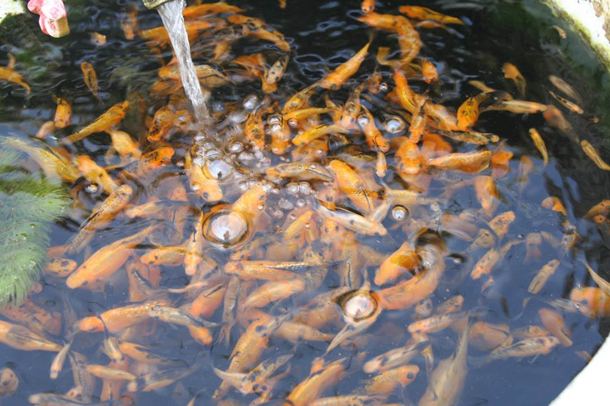This blog results from an email I got from a hobbyist, Christy. She wrote:
“Hello,
I’m a small hobbyist and I was wondering if you would share your breeding setups for platies and mollies. It sounds like you get a good number of fish from your tanks with the schedule and setup.
Best of wishes for your fishes!”
Here’s my answer to Christy:
First I’ll tell you how we raise our fish. Then I’ll suggest how a hobbyist might do so.
We breed each of our livebearer strains in three 55 gallon vats, each containing about 45 gallons of water.
The first critical factor to consider is water quality. We accomplish pristine water conditions using plant filtration and recirculation. Each vat has one or two taps from a water line. These run water into the vat with the flow set to turn over 100% hourly. The water in each vat overflows into a floor gutter (the greenhouse floor has about six inches of water). The floor gutter flows into a sump where large pumps pump the water back to the vats. We use no chemical or mechanical filtration. However, we have large amount of plants, including hornwort (Ceratophyllum demersum) in the vats and red mangrove (Rhizophora mangle), black mangrove (Avicennia germinans), and hoja santa (Piper auritum) planted and growing in the floor gutter. The hornwort is aquatic, while the other three plants thrive with their roots in the water, but their stems and leaves out of the water. Collectively, these plants keep ammonia levels at zero despite a heavy feeding regimen and large numbers of fish. To provide additional aeration, each vat is equipped with a bare airline. The airline is open with stainless steel nuts threaded over the line to weigh it down. No airstones are used. We don’t do water changes, but our operations tend to remove 1-2% of the water daily. This is replaced with well water.
Feeding is also critical; the more you can get your fish to eat, the faster and larger they grow. We feed our livebearers foods provided by Simple Pet Products. First thing in the morning they are fed floating pellets (42% protein). The fish can pick at the pellets and we can easily see how much they eating. Early afternoon and late afternoon they are fed slow sinking grinds (50% protein). The size of the grind fed is dependent on the size of the fish. Fry receive #100 grind as do small adults such as guppies and platies. Larger fish are fed #200 grind and very large fish, such as some of the mollies, receive #300 grind. As I’ll discuss below, we crowd our fish. How does this relate to feeding? Simple, crowded fish eat more food per fish. The competition and the fact others are eating seem to stimulate a given fish to eat more than it would if it were alone.
Lighting is not that important. We use only natural lighting since we raise our fish in greenhouses. That means our fish don’t have as many daylight hours in the winter to eat more and their growth rates decline. Lower water temperatures also play a part in this growth rate decline. One thing to consider when using artificial lighting is that the Xiphophorus Genetic Stock Center (see my article about them in the June 2014 issue of Tropical Fish Hobbyist magazine) found that full spectrum lighting led to larger brood sizes than did regular fluorescent lighting.
Temperature controls grow rates and brood cycles. Our winter water temperatures range from lows of 68°F and averages 75°F. Our summer water temperatures average around 82°F, occasionally topping out at 88°F. Daily water temperatures vary by about 5-8°F, with temperatures being lower in the morning and higher in the evening.
Our well water is hard (285 ppm calcium carbonate) and alkaline (pH 8.5). pH varies from about 8.0 in the morning to 8.5 in the afternoon, caused respectively by plant respiration and photosynthesis.
Now that I’ve covered the environmental conditions, let’s go to our rearing techniques.
As I said at the beginning, we raise each of our livebearer varieties, both species and domestic strains, in three 55 gallon vats. One vat holds the breeding colony, another juveniles to grow up, and the last is the sale vat. I’ll take these in reverse order. The sale vat houses the fish we are offering for sale. With platies and guppies we might have 600 fish in each vat. With swords and mollies that number may be as high as 300-400. The juvenile vat typically has 600-1000 fish ranging from fry to half-grown juveniles. Both the sale and juvenile vat are stocked with hornwort covering about a half of the water surface; any more than that interferes with feeding. Excess hornwort is thrown into our worm beds as food for them. The breeding colony usually consists of six males and 40-60 females. The breeding vat has hornwort and is also equipped with a breeding cage. A livebearer breeding cage is a closed bottom cylinder a foot in diameter and extending from the bottom of the vat to several inches above the water’s surface. It is fashioned from 1/4” aquaculture non-toxic mesh. For a description for making one, see my article in Tropical Fish Hobbyist magazine archives. The adult fish are outside the cage. New fry will hide inside the cage safe from the adults.
To begin a new breeding cycle, which is done every three months, we start by breaking down the sale vat. The fish are netted out into five-gallon buckets with airlines placed in them for aeration. These fish are sorted and inventoried. The best fish are set aside as potential breeders. Their vat is cleaned by siphoning the water out into the floor gutter and, using a 10” brine shrimp net, removing the mulm that has accumulated on the bottom of the vat. Next the juvenile vat is cleaned. The juveniles are sized sorted and inventoried. Adult sized fish will be added to the sale vat. Smaller fish will be placed with the current fry and juveniles from the breeding colony. Finally, the breeding colony is broken down. The breeding cage is removed and the adults are netted out. This vat is not cleaned and the fry and juveniles remain. The breeders are inventoried.
Now that all the vats are ready, the breeders are placed into the erstwhile sale vat into which the breeding cage is placed. Any missing breeders are made up from the potential breeders set aside earlier. The vat that had housed juveniles now becomes the new sale vat and the sellable sized adults are counted into it. The remaining juveniles are placed in the vat that had been the breeding colony. So, we end up with a breeding colony, a juvenile and fry vat, and a sale vat, all inventoried and ready to go.
Now how can a hobbyist manage this? First of all, let me point out that I began the development of these techniques and systems as a student living in an apartment. So, you don’t have to have greenhouses to raise lots of fish.
When I raised fish in an apartment, I built 2”X4” wooden racks that held ten-gallon tanks. I used sponge filters for filtration since that provided some biological filtration. I used airstones to provide vigorous aeration. I used no gravel since gravel complicated cleaning. I used hornwort to provide some ammonia control and to provide fry cover. I changed 90% of the water at least once a week to completely control ammonia. I fed a little food at a time, but frequently, several times a day. I crowded the fish so they’d eat more. Typically I’d have 100+ guppies in a ten gallon tank. Today, I would probably plumb the tanks and have a plant tank. Water would be pumped from the plant tank into each tank, overflow into plumbing, return to the plant tank. But, with good filtration and massive water changes it could still be done the way I did as a student.
I hope this helped Christy and encouraged her to follow up with questions. To show you how densely we keep fish, the photo shows an adult molly sale vat with more the 300 3-4 inch fish in it.


Aaron says
I’ve heard that fish release a hormone that will slow the growth of other similar fish. Do you agree or would you not be able to tell even though you raise so many close together without water changes because the total water amount in your system is so great?
Charles Clapsaddle says
Aaron,
There are reports in aquaculture of fish excreting substances that inhibit growth of other fish. I’ve not seen that happen in our systems. While we have lots of water, we also have lots of fish biomass. In addition to the fish in our vats, we have many feral fish living and breeding in the sumps and floor gutters. I suspect all the biologic activity from the plants and microorganisms in our systems have some impact. This subject requires more time and space than I have here, so you’ve nudged me into doing a blog about it. When I publish the blog, I’ll provide a link to it in a reply to you. Maybe a week?
Charles
Aaron says
I’ll look forward to it. Thank you very much for your time. I’m not too far from you, just up in Fort Worth.